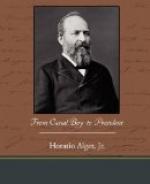James was very much mortified, and repaired damages as well as he could with a pin.
“I need a new suit of clothes badly,” he said in the evening, “but I can’t afford to buy one. See how I have torn my trowsers.”
“Oh, that is easy enough to mend,” said Mrs. Stiles, cheerfully.
“But I have no other pair to wear while they are being mended,” said James, with a blush.
“Then you must go to bed early, and send them down by one of the boys. I will darn the hole so that you will never know it. You won’t mind such trifles when you become President.”
It was a jocose remark, and the good lady little dreamed that, in after years, the young man with but one pair of pantaloons, and those more than half worn, would occupy the proud position she referred to.
CHAPTER X.
A COUSIN’S REMINISCENCES.
During his school-life at Geauga Seminary James enjoyed the companionship of a cousin, Henry B. Boynton, who still lives on the farm adjoining the one on which our hero was born. The relationship between the two boys was much closer than is common between cousins; for while their mothers were sisters, their fathers were half-brothers. Henry was two years older than James, and they were more like brothers than cousins. I am sure my young readers will be glad to read what Henry has to say of their joint school-life. I quote from the account of an interview held with a correspondent of the Boston Herald, bearing the date of September 23, 1881:
When General Garfield was nominated to the Presidency his old neighbors in Orange erected a flag-staff where the house stood which Garfield and his brother erected for their mother and sisters with their own hands, after the log hut, a little farther out in the field nearer the wood, had become unfit for habitation. Thomas Garfield, the uncle of the President, who not long since was killed by a railroad accident, directed the manual labor of rearing the shaft, and was proud of his work.
There is nothing except this hole left to mark his birth-place, and the old well, not two rods off, which he and his brother dug to furnish water for the family. In the little maple grove to the left, children played about the school-house where the dead President first gathered the rudiments upon which he built to such purpose. The old orchard in its sere and yellow leaf, the dying grass, and the turning maple leaves seemed to join in the great mourning.
Adjoining the field where the flag floats is an unpretentious home, almost as much identified with Gen. Garfield’s early history as the one he helped to clear of the forest timber while he was yet but a child. It is the home of Henry B. Boynton, cousin of the dead President, and a brother of Dr. Boynton, whose name has become so well known from recent events.
“While rambling over this place the correspondent came upon this near relative of Garfield, smaller in stature than he was, but in features bearing a striking resemblance to him.




